Socail approach Study guides, Revision notes & Summaries
Looking for the best study guides, study notes and summaries about Socail approach? On this page you'll find 15 study documents about Socail approach.
All 15 results
Sort by
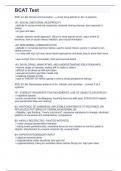
-
BCAT Test
- Exam (elaborations) • 21 pages • 2023
-
- £11.72
- + learn more
BCAT Test ASD: A1-A3: Social communication - >>must have deficits in ALL 3 sections -A1: SOCIAL EMOTIONAL RECIPROCITY >deficits in social emotional reciprocity, reduced sharing interest, dont respond to smiles >no give and take >sympt: abnorm socail approach, failure to have typical convo, reduc share of emotions, lack of social interac initiation, poor social immitation -A2: NONVERBAL COMMUNICATION >deficits in nonverbal commun behav used in social interac, poorly ...
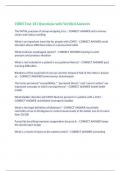
-
CRRN Test 181 Questions with Verified Answers,100% CORRECT
- Exam (elaborations) • 17 pages • 2024
- Available in package deal
-
- £10.50
- + learn more
CRRN Test 181 Questions with Verified Answers The INITIAL purpose of stump wrapping is to: - CORRECT ANSWER aid in venous return and reduce swelling What is an important travel tip for people with COPD? - CORRECT ANSWER avoid elevation above 4000 feet unless in a pressurized cabin What produces esophageal speech? - CORRECT ANSWER burping to exert pressure and produce vibration What is not included in a patient's occupational history? - CORRECT ANSWER past learning difficulties Bl...
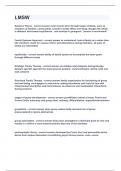
-
LMSW|2023 LATEST UPDATE|GUARANTEED SUCCESS
- Exam (elaborations) • 16 pages • 2023
- Available in package deal
-
- £10.91
- + learn more
Systems Theory views human bhvr through larger contexts, such as members of families, communities, broader society. When one thing changes the whole is affected. tend toward equilibrium . use ecomap or genogram. "person in enviroment" Family Systems Approach to understand: look at family as a whole then idiv members. looks for causes of bhvr and interections among members. all parts of family are interrelated equifinality ability of family system to accomplish the same goals t...
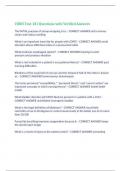
-
CRRN Test 181 Questions with Verified Answers,100% CORRECT
- Exam (elaborations) • 17 pages • 2024
-
- £10.10
- + learn more
CRRN Test 181 Questions with Verified Answers The INITIAL purpose of stump wrapping is to: - CORRECT ANSWER aid in venous return and reduce swelling What is an important travel tip for people with COPD? - CORRECT ANSWER avoid elevation above 4000 feet unless in a pressurized cabin What produces esophageal speech? - CORRECT ANSWER burping to exert pressure and produce vibration What is not included in a patient's occupational history? - CORRECT ANSWER past learning difficulties Bl...
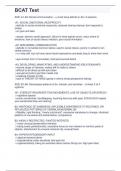
-
BCAT Test.
- Exam (elaborations) • 21 pages • 2023
-
- £13.33
- + learn more
ASD: A1-A3: Social communication - >>must have deficits in ALL 3 sections -A1: SOCIAL EMOTIONAL RECIPROCITY >deficits in social emotional reciprocity, reduced sharing interest, dont respond to smiles >no give and take >sympt: abnorm socail approach, failure to have typical convo, reduc share of emotions, lack of social interac initiation, poor social immitation -A2: NONVERBAL COMMUNICATION >deficits in nonverbal commun behav used in social interac, poorly in verbal t...
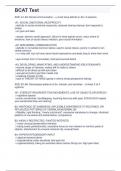
-
BCAT Test
- Exam (elaborations) • 21 pages • 2023
-
- £10.50
- + learn more
BCAT Test ASD: A1-A3: Social communication - >>must have deficits in ALL 3 sections -A1: SOCIAL EMOTIONAL RECIPROCITY >deficits in social emotional reciprocity, reduced sharing interest, dont respond to smiles >no give and take >sympt: abnorm socail approach, failure to have typical convo, reduc share of emotions, lack of social interac initiation, poor social immitation -A2: NONVERBAL COMMUNICATION >deficits in nonverbal commun behav used in social interac, poorly ...
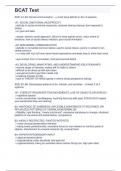
-
BCAT Test with Correct Answers
- Exam (elaborations) • 21 pages • 2023
-
- £8.48
- + learn more
BCAT Test ASD: A1-A3: Social communication - >>must have deficits in ALL 3 sections -A1: SOCIAL EMOTIONAL RECIPROCITY >deficits in social emotional reciprocity, reduced sharing interest, dont respond to smiles >no give and take >sympt: abnorm socail approach, failure to have typical convo, reduc share of emotions, lack of social interac initiation, poor social immitation -A2: NONVERBAL COMMUNICATION >deficits in nonverbal commun behav used in social interac, poorly ...
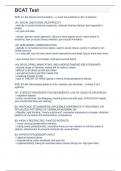
-
BCAT Test
- Exam (elaborations) • 21 pages • 2023
-
- £11.31
- + learn more
BCAT Test ASD: A1-A3: Social communication - >>must have deficits in ALL 3 sections -A1: SOCIAL EMOTIONAL RECIPROCITY >deficits in social emotional reciprocity, reduced sharing interest, dont respond to smiles >no give and take >sympt: abnorm socail approach, failure to have typical convo, reduc share of emotions, lack of social interac initiation, poor social immitation -A2: NONVERBAL COMMUNICATION >deficits in nonverbal commun behav used in social interac, poorly ...
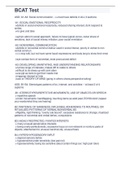
-
BCAT Test
- Exam (elaborations) • 21 pages • 2023
-
- £7.67
- + learn more
ASD: A1-A3: Social communication - >>must have deficits in ALL 3 sections -A1: SOCIAL EMOTIONAL RECIPROCITY >deficits in social emotional reciprocity, reduced sharing interest, dont respond to smiles >no give and take >sympt: abnorm socail approach, failure to have typical convo, reduc share of emotions, lack of social interac initiation, poor social immitation -A2: NONVERBAL COMMUNICATION >deficits in nonverbal commun behav used in social interac, poorly in verbal t...
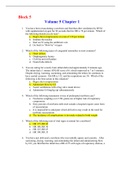
-
PAR 100 San Diego Miramar College Vol 5 Chapter 1 to 14
- Exam (elaborations) • 46 pages • 2022
-
- £24.25
- + learn more
PAR 100 Volume 5 Chapters 1 to 14 Chapter 1 1. You have been resuscitating a newborn and find that after ventilation by BVM with supplemental oxygen for 30 seconds that his HR is 78 per minute. Which of the following should you do next? 2. Which of the following types of congenital anomalies is most common? 3. You are caring for a newly born infant delivered approximately 8 minutes ago. The infant had a 1 minute APGAR score of 6, which improved to 7 at 5 minutes. Despite drying, w...

Do you wonder why so many students wear nice clothes, have money to spare and enjoy tons of free time? Well, they sell on Stuvia! Imagine your study notes being downloaded a dozen times for £15 each. Every. Single. Day. Discover all about earning on Stuvia


